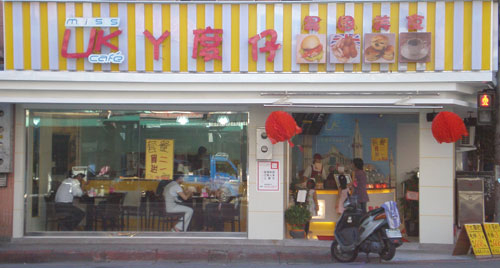Imagine some white guys in a fairly large U.S. city open a restaurant named “Mr. Taiwan Slant-Eyes Asian Cuisine.” And imagine that this restaurant specializes in distinctly Americanized dishes such as egg foo yong, fortune cookies, and California wraps. Now imagine the response. Isn’t this fun?
OK, now imagine a different situation: In Taiwan’s fifth-largest city some locals open a place specializing in Taiwanized Western food and dub their restaurant “Miss UK Cafe Pointy-Nose Foreign Food.”
As you’ve probably guessed, the second scenario is real. The “Miss UK Cafe ㄚ度仔 異國美食” (Miss UK Cafe a-tok-a yìguó měishí) recently opened not far from my apartment in Banqiao.
A-tok-a (ㄚ度仔) is Taiwanese for “pointy nose” (i.e., Westerner), though perhaps the common translation of “big nose” conveys the spirit a little better. As Tempo Gain explains in the Forumosa thread on this word, “the initial ‘a’ often preceds names, and the final ‘a’ often is attached to nouns like the Mandarin ‘zi’ haizi, chezi, etc.”
Although most foreigners I know in Taiwan find the use of a-tok-a offensive to some degree, reactions are usually tempered by the knowledge that the word is very seldom used intentionally as a pejorative. It’s just the word most Hoklo speakers would use for “Westerner,” and they mean nothing bad by this and perhaps even see it as “cute” in a favorable way. So since I’m certain the restaurateurs didn’t intend any insult in choosing this name, I’m not going to carp about this any more than I already have — which is not to say that I will ever buy anything from that restaurant.
It’s still an interesting name, though. (Actually, this is probably two names: the standard one (ㄚ度仔 異國美食), which is for most people, and the English one (Miss UK Cafe), which is probably there in an attempt to look modern/foreign/cool.)
For those keeping count, that’s three scripts and as many languages on just one sign.
- Miss UK Cafe: English, in the Roman alphabet
- ㄚ度仔: Taiwanese, in a mixed script of zhuyin (ㄚ) and Chinese characters
- 異國美食: Mandarin, in Chinese characters
The mixing of scripts in “ㄚ度仔” is representative of the sad fact that most people in Taiwan are unsure how to write Taiwanese. Here are some of the ways this word gets written, along with the number of Google results and Baidu results for that exact phrase.
- ㄚ度仔 Google 555 / Baidu doesn’t recognize the ㄚ
- 阿凸仔 3,440 / Baidu 1,320
- 阿多仔 6,730/ Baidu 13,400
- 阿卓仔 11,300 / Baidu 2,810
- 阿荳仔 12,500 / Baidu 24,700
- 阿豆仔 12,500 / Baidu 24,700 (Google and Baidu apparently refuse to differentiate 荳 and 豆)
Also interesting is the use of yìguó (異國) instead of the more common wàiguó (外國), for “foreign.”
- “異國” Google 1,510,000 / Baidu 14,700,000
- “外國” Google 6,420,000 / Baidu 46,500,000
Yìguó měishí, however, is more common than wàiguó měishí.
- “外國美食” Google 41,100 / Baidu 26,400
- “異國美食” Google 114,000 / Baidu 152,000
This, I suspect, is because yìguó měishí “sounds fancier” because of how relatively common the word waiguo is.

further reading:

